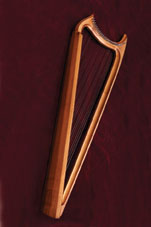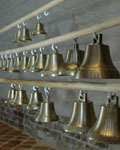Medieval transverse flutes
Transverse flutes can be found in Western poetry and art at least as early as the 11th century. This relatively loud instrument with its large fingerholes is practically identical with flutes used in North Indian classical music. The fingering techniques of the Indian flute are also perfectly applicable to similar medieval instruments.

What kind of transverse flutes were played in medieval Europe and what they sounded like can only be guessed by piecing together a kaleidoscope of information preserved in the graphic arts, in literary and poetic works touching on the performance practice of medieval instrumental music, in folk music traditions using similar instruments and â there is no hiding that anyway! â adding a certain measure of personal imagination to the mix. No doubt the medieval transverse flute was similar in its construction to the oldest flutes, reports of which have been recorded in Asia, a part of the world where the instrument has enjoyed continued popular use from ancient times until the present. The flutes in question are more or less cylindrical in shape, with six or seven finger holes in addition to the blowing hole. As regards the material used to make flutes, it is highly probable that flutes were made chiefly of wood and bone, yet graphic arts fragments clearly point also to bamboo. In addition, magnificent-sounding transverse flutes can also be made of clay. Two clay flutes, in g and in c, were made in 2006/7 by Raho Langsepp in cooperation with ceramist Anneli Lupp. When thinking of other possible materials which could be used for making flutes in Europe, Raho Langsepp worked out special models made of clay and covered with birch bark; these can be heard in this program as well as a bass flute in C made by Raho Langsepp in 2007.
Xun
The xun is a clay flute with a spherical shape - it is thus also described as a vessel flute or globular flute, or called an ocarina, the name of a similar Western instrument. It is one of the earliest known musical instruments - the earliest xun have been found in Chinese archaeological sites as early as 5000 BCE. They are also mentioned in classical writings such as the Book of Songs. The xun is thus regarded as a national instrument of the Han Chinese people. However, although xun may have been played in various ceremonial orchestras, there was little mention of it in Chinese written sources until recent archaeological findings regenerated its popularity. Today it is widely heard, insinuating itself into movie soundtracks and popular music. The xun has a most peculiar and interesting timbre - its plaintive, deep and versatile sound can also be used for unique imitations of the human voice. Physically it is an egg-shaped hollow vessel with a blowing hole at top center and finger holes spread around the sides. Similarly to transverse flutes, the correct embouchure is the key to producing the correct tone. The number of finger holes varies from five to seven, although the modern instruments may sometimes have even more. Traditionally the xun had a range of just one octave.Gothic harp
 The world of medieval harps was amazingly rich in varying sizes, shapes and numbers of strings. The harp used to record this album is a copy (made in 2000 by the German master harp maker Eric Wilhelm Kleinmann). The original, which is kept at the Wartburg Art-Collection in Eisenach, in all likelihood used to belong to the famous Minnesinger Oswald von Wolkenstein (1377â1445). The slim, Gothic-looking harp has 26 strings (range G â d'''), tuned diatonically. Additional semitones can be played by reducing the vibrating length of the strings. In addition to its wide musical range, owing to the number of strings fitted on the instrument, the Wartburg/Wolkenstein harp is characterised by a rich timbre and lends itself easily to dynamic playing techniques. It is also noteworthy that the entire instrument is equipped with L-shaped bray pins permitting the player to create a vibrant buzzing sound characteristic of medieval harps. By varying the position of the pins, the harp can be used to play quietly yet in a highly nuanced dynamic manner.
The world of medieval harps was amazingly rich in varying sizes, shapes and numbers of strings. The harp used to record this album is a copy (made in 2000 by the German master harp maker Eric Wilhelm Kleinmann). The original, which is kept at the Wartburg Art-Collection in Eisenach, in all likelihood used to belong to the famous Minnesinger Oswald von Wolkenstein (1377â1445). The slim, Gothic-looking harp has 26 strings (range G â d'''), tuned diatonically. Additional semitones can be played by reducing the vibrating length of the strings. In addition to its wide musical range, owing to the number of strings fitted on the instrument, the Wartburg/Wolkenstein harp is characterised by a rich timbre and lends itself easily to dynamic playing techniques. It is also noteworthy that the entire instrument is equipped with L-shaped bray pins permitting the player to create a vibrant buzzing sound characteristic of medieval harps. By varying the position of the pins, the harp can be used to play quietly yet in a highly nuanced dynamic manner.
Bell chime
 Although not commonly used for performances of early Western music, sets of small chime bells are depicted in numerous medieval illustrations. These most commonly show them played by the ancient Greek philosopher Pythagoras. The set of bell chimes used here (range AâfÂŽ) consists of bells made by the Swedish family firm Morells Metallgjuteri AB, established in 1920. In founding and hand working their bells the firm employs traditional methods descended from their forefathers.
Although not commonly used for performances of early Western music, sets of small chime bells are depicted in numerous medieval illustrations. These most commonly show them played by the ancient Greek philosopher Pythagoras. The set of bell chimes used here (range AâfÂŽ) consists of bells made by the Swedish family firm Morells Metallgjuteri AB, established in 1920. In founding and hand working their bells the firm employs traditional methods descended from their forefathers.



